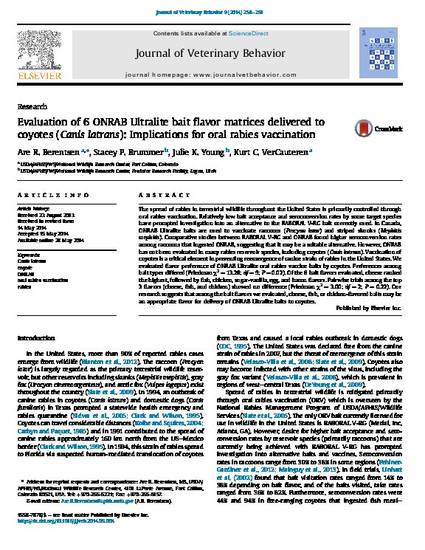
ournal of Veterinary Behavior 9 (2014) 258--261
The spread of rabies in terrestrial wildlife throughout the United States is primarily controlled through oral rabies vaccination. Relatively low bait acceptance and seroconversion rates by some target species have prompted investigation into an alternative to the RABORAL V-RG bait currently used. In Canada, ONRAB Ultralite baits are used to vaccinate raccoons (Procyon lotor) and striped skunks (Mephitis mephitis). Comparative studies between RABORAL V-RG and ONRAB found higher seroconversion rates among raccoons that ingested ONRAB, suggesting that it may be a suitable alternative. However, ONRAB has not been evaluated in many rabies reservoir species, including coyotes (Canis latrans). Vaccination of coyotes is a critical element in preventing reemergence of canine strain of rabies in the United States.We evaluated flavor preference of ONRAB Ultralite oral rabies vaccine baits by coyotes. Preferences among bait types differed (Friedman c2 ¼ 13.28; df ¼ 5; P ¼ 0.02). Of the 6 bait flavors evaluated, cheese ranked the highest, followed by fish, chicken, sugar-vanilla, egg, and bacon flavors. Pairwise trials among the top 3 flavors (cheese, fish, and chicken) showed no difference (Friedman c2 ¼ 3.00; df ¼ 2; P ¼ 0.22). Our research suggests that among the bait flavors we evaluated, cheese, fish, or chicken-flavored baits may be an appropriate flavor for delivery of ONRAB Ultralite baits to coyotes.
Available at: http://works.bepress.com/julie_young1/218/

U.S. government work.